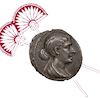
11. IVORY
VOICE BIvory has been used since ancient times to make a range of decorative items, including fans. Most ivory carved in Europe originated in Africa. Elephant ivory is the primary source, distinguished by its extraordinary workability. Carvers used axes and chisels for stripping the outer rind from the tusk, then saws for cutting the tusk into manageable sections and then an instrument called a float to pare the surface. VOICE AOnly then would the carver use fretsaws, gauges and hand chisels to carve out the piece. You can see a selection of tools used by ivory workers on the lower shelf of this section. On the middle shelf is an example of a late 18th century Chinese fan made entirely from ivory for export to the West. It is carved, pierced and pared. The surface is lace-like in its delicacy and would have matched beautifully the muslin and cotton dresses fashionable at this time.


The Fan Museum
The Fan Museum is the UK's only organisation of its kind, devoted entirely to the subject of fans and craft of fan making. Housed in two beautifully restored Georgian period townhouses, its collections number more than 7,000 objects dating from the 12th century to present day.
